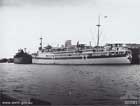 Attitudes to the war Australian and Japanese attitudes to the war |
The Japanese sections each deal with an individual account of the war in New Guinea from a Japanese perspective, albeit two very different Japanese perspectives. The excerpts taken from diary of TAMURA Yoshikazu give us an insight into the life of the ordinary Japanese soldier. We follow him over an eight month period from April to December 1943 when it is presumed he was killed in action. During this time we read of his hopes and feelings, of life in the jungle, and his thoughts on war and death. The original diary was deposited with the Australian War Memorial, but has since been returned to TAMURA's surviving family in Japan.
By contrast Southern Cross is an account of the operations of the Japanese 18th Army in New Guinea as told by its former Chief of Staff, Lieutenant General YOSHIHARA Kane. Here the emphasis is on describing the "big picture" of the Japanese war effort in New Guinea. As well as military operations YOSHIAHARA makes a number of detailed observations on the relationship with the local New Guinean and Papuan peoples, as well as the fauna and flora and general nature of the country. Nonetheless the bulk of his work is taken up with the task of recording the 18th Army's performance over three years of warfare and it is fascinating to see how the Japanese high command viewed the same situations and events in comparison to their better documented and more widely known Australian and American counterparts.
Overview links
 Overview
Overview
Attitudes links
| Overview | ||
| Australian Attitudes | ||
| Tamura diary | ||
| Southern Cross | ||
| Midget Submarine | ||
Click images to enlarge.

AWM 303581
The AJRP has wound up its activities at the Memorial for the moment. Please contact the relevant officer of the Australian War Memorial for assistance. Internet implementation by Fulton Technology and AJRP staff . Visit the Australian War Memorial home page. |